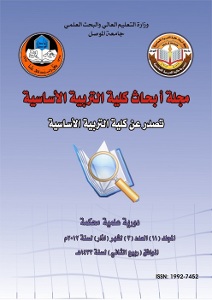Measuring Recall Ability of children between(5-6) Years Old
Abstract
(5-6) :- (5-6) .- (5-6) . (24) (12) (6) (120) (20) . (36) (6) (36) (CD) (36) (6) (2) (5) (5) : ( () (5-6) (5-6) .The aim of this paper is to know the recall ability of children whose age range between 5-6 years. It also tries to examine whether or not there is any statistical significant difference in the children level of recall with regard to sex variable.The two researchers have used the descriptive approach. The sample of the paper includes all kindergartens in the center of Ninevah governarate. The sample was identified accurately through the use of the statistical means available in Ninevah Educational Directorate. The researchers have purposely chosen kindergartens in the left-side of city center which are twelve in number. The left-side of Mosul city was divided into six geographical areas. The researchers have chosen one kindergarten from each region. The total number of the sample is (120) male and female children, i.e. (20) children in each kindergarten. The researchers have designed a test which consists of (36) coloured sport pictures related to the childrens environment, in addition to other six pictures used for misleading. The (36) pictures are written on CD and are presented to the children by the computer. The pictures were divided into groups each of whichcontains six pictures. There was an interval of two seconds between presenting one picture and the other and an interval of (5) seconds between presenting one group and another. The child has to collect the pictures he has seen during the five seconds he was given. The researchers have used the following statistical means:-Arithmetic mean, standard deviation, hypothetical mean, and the T-test. The results have shown that:-All children whose age is between 5-6 years have a good level of recall. There is a significant statistical difference in the ability to recall between males and females and for the benefit of the females.





